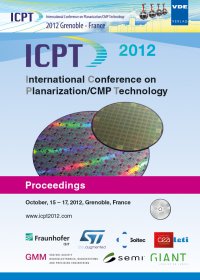Topography Understanding of Tungsten Chemical Mechanical Polishing for Advanced Technology
Conference: ICPT 2012 - International Conference on Planarization / CMP Technology
10/15/2012 - 10/17/2012 at Grenoble, France
Proceedings: ICPT 2012
Pages: 6Language: englishTyp: PDF
Personal VDE Members are entitled to a 10% discount on this title
Authors:
Yu, Hong; Moon, Yongsik; Liu, Huang (ID-AMID, Globalfoundries, 107 Herrnes Road, Malta, NY 12020, USA)
Abstract:
As very large scale integrated (VLSI) fabrication technology continuously scales down, the requirements for contact tungsten chemical mechanical polishing (WCMP) become more and more stringent. Erosion and local plug protrusion are two critical factors to determine the integrity and reliability of WCMP. High erosion could be translated to metal 1 (Ml) shorts or copper puddle after copper CMP. High plug protrusion could give rise to the defects of slurry particles, which were trapped between the tungsten plugs. In addition, it was found there is a contradictory relationship of erosion and ping protrusion. Therefore, it becomes much challenging to minimize both the erosion and plug protrusion for advanced technology. In this paper, a study was conducted to understand the impact of tungsten polishing on the final erosion and plug protrusion with a fixed oxide buff. The tungsten removal, polishing rate, and uniformity were taken into consideration. It was found that less tungsten over-polishing time could lead to higher plug protrusion, while more tungsten over-polishing time could result in larger erosion. The decrease of tungsten removal rate could lower the removal amount of tungsten plugs and result in less plug recess after tungsten polishing, and consequently the final plug protrusion increased with a fixed correction of oxide buff. Moreover, a center-slow profile of tungsten removal rate caused a large non-uniformity of ping protrusion across the wafer. Thereby, slurry particles were observed in the center of wafer due to high plug protrusion. It is suggested that an advanced process control is needed for the correction of the drift of tungsten removal rate and profile. Also, in order to completely address the influence of both tungsten and oxide polishing on erosion and plug protrusion, we modified a previously proposed model to incorporate the factors of tungsten polishing. Generally, this model is able to provide a guideline to understand the formation of topography under complex conditions such as multi-steps and multi -slurries.


